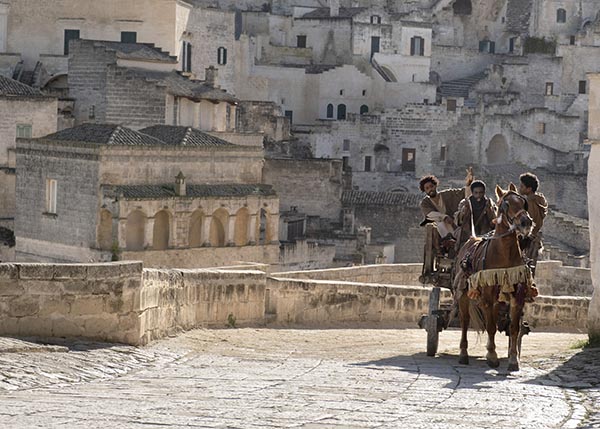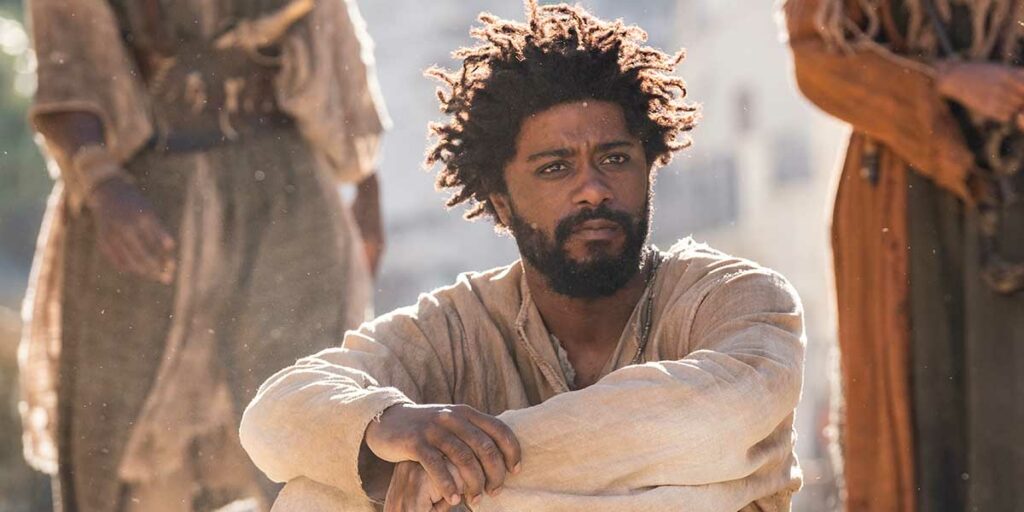The Book of Clarence delivers a fascinating story where biblical epic tones are mixed with humour and satire.
As I walked into my morning screening of The Book of Clarence, I did not know much about the film except for its biblical setting, but with its wit and humour, it quickly won me over. Normally, you would think that the biblical epic and comedy are two genres that do not go together. But The Book of Clarence mixes the two so brilliantly that it proves that this combination can become a successful product: perhaps it shouldn’t work, but it does here. With his latest film, Jeymes Samuel (The Harder they Fall) tells a story set almost 2000 years ago but that still manages to be relevant to today’s world and comment on our present with its themes.
The Book of Clarence opens in Jerusalem in AD 33, when we are introduced to Clarence (LaKeith Stanfield), a man struggling to find his way and get back on his feet. Determined to change his life and pay back the debt he owes to the local gangster, Clarence embarks on a journey to capitalise on the influence and respect that is conferred to Jesus and his apostles, including Clarence’s estranged twin brother Thomas (LaKeith Stanfield), in Jerusalem. In turning his fortune around, Clarence can count on the help of his friends, Elijah (RJ Cyler) and Barabbas (Omar Sy), a formerly enslaved gladiator.
Despite not using a biblical story, strictly speaking, but rather focusing on an ordinary man, The Book of Clarence has many religious references, both in the script and its visuals. For example, there is a scene in the second half of the film that recreates the structure and composition of Leonardo da Vinci’s Last Supper, one of the most famous moments in the Bible and one of the most renowned religious paintings. Jesus is also consistently shown in his traditional colours, white and red, making him immediately identifiable from the costume design alone.
The visual representation of Jesus is something biblical epics always have to come to terms with, in choosing how to portray a holy figure. In this film, Samuel opts for not showing Jesus’ face in the entire first half of the film. When Jesus is introduced and shown, it is always from the back or with his face hidden by his clothes or the halo of the sun. This together with the frequent use of low angles when showing Jesus on screen conveys an aura of mystery, respect, and reverence to his character. Therefore, the moment when Jesus’s face is finally shown is even more powerful as the audience witnesses one of the miracles on screen.

Most importantly, Jesus, his apostles and all the people of Jerusalem, including the main character, are Black. This is particularly significant as Samuel chose to step away from a tradition in biblical epic films that sees all the characters portrayed as white. However, this interpretation is not only more historically correct, as most people in Judea at the time of Jesus Christ had olive or brown skin, but also entirely more truthful and significant. In fact, in The Book of Clarence, we get to see Black actors portray this marginalised group of characters who are oppressed by the powerful Roman Empire. As the latter is all portrayed by a white cast, the film’s commentary on oppression and colonisation is even stronger.
One of the biggest strengths of The Book of Clarence is its commentary on the present, despite narrating a story set in a distant past we only know about through scriptures. The themes analysed in this film are very relevant to the modern world: from the aforementioned marginalisation of minorities to Clarence’s obsession with the rise to fame, which will grant him power and protection, everything resonates with modern worries and anxieties.
The score, by Samuels himself, and the song choices, predominantly modern hip-hop and rap music, also bring the story to the present. While this is an interesting and bold choice, I am not sure it completely works as I found the score to be too overpowering at times, particularly at the beginning of the film. Similarly, the use of modern language and modern figures of speech is something the audience needs to get used to and that can seem jarring at first.
The third act of the film is regrettably the weakest, as I could not help but feel like the movie dragged on a little bit too much. I think that the biggest strength in The Book of Clarence is the ambiguity and mystery around Jesus and his apostles. During the first two acts we barely see them or hear them speak, all the audience knows of these figures is what the other characters tell us. This works well as it allows the audience to create their interpretation of these characters most of us will already be familiar with. However, a lot of this is lost in the final act as Jesus and the apostles play a much bigger role in Clarence’s story.
All things considered, I enjoyed The Book of Clarence, a film that plays with the convention of its genre, innovating and envisioning what a biblical epic film can look like in 2023. In an age when this genre of filmmaking seems to have been set aside, Samuel shows us that a film inspired by the Bible can still be funny and engaging. It is also a movie that will keep its audience laughing for most of its runtime but does not shy away from portraying more intimate and touching moments, while also creating scenes with high tension and beautiful scenery.
The Book of Clarence screened at the 2023 BFI London Film Festival and will be released in US theaters on January 12, 2024.

